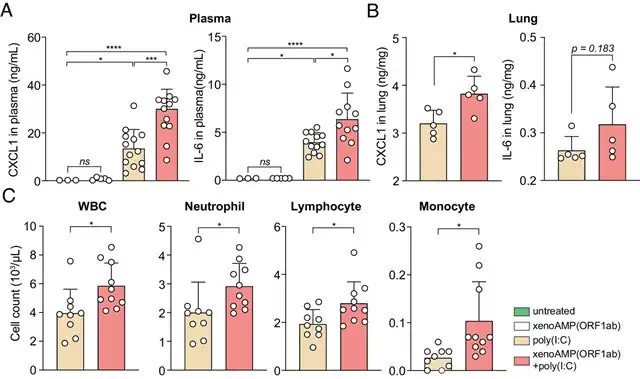Zombie” Coronavirus Fragments Could Be Culprit Behind Severe Cases
- Normal Liver Cells Found to Promote Cancer Metastasis to the Liver
- Nearly 80% Complete Remission: Breakthrough in ADC Anti-Tumor Treatment
- Vaccination Against Common Diseases May Prevent Dementia!
- New Alzheimer’s Disease (AD) Diagnosis and Staging Criteria
- Breakthrough in Alzheimer’s Disease: New Nasal Spray Halts Cognitive Decline by Targeting Toxic Protein
- Can the Tap Water at the Paris Olympics be Drunk Directly?
Zombie” Coronavirus Fragments Could Be Culprit Behind Severe Cases
- Should China be held legally responsible for the US’s $18 trillion COVID losses?
- CT Radiation Exposure Linked to Blood Cancer in Children and Adolescents
- FDA has mandated a top-level black box warning for all marketed CAR-T therapies
- Can people with high blood pressure eat peanuts?
- What is the difference between dopamine and dobutamine?
- How long can the patient live after heart stent surgery?
Zombie” Coronavirus Fragments Could Be Culprit Behind Severe Cases
Following the emergence of SARS-CoV-2 in 2020, there are now known to be seven different coronaviruses that can infect humans. While four are associated with common, relatively harmless respiratory infections, the other three (SARS, SARS-CoV-2, and MERS) are much more dangerous.
The mystery of why some coronaviruses are relatively benign while others are unbelievably lethal remains. One key may lie in the proteins each virus uses when entering human cells, but what makes SARS-CoV-2 so severe in some individuals while harmless in others is still unclear.
A groundbreaking new study led by researchers at the University of California, Los Angeles, proposes a novel hypothesis to explain the severity of SARS-CoV-2. Using an artificial intelligence-driven machine learning system, the researchers discovered that SARS-CoV-2 breaks down into fragments in the human body that closely resemble endogenous peptides, which can excessively stimulate the immune system. This could be a crucial factor in the varying severity of the disease.
“Our textbooks tell us that once the virus is eliminated, the sick host ‘wins,’ and different viral fragments can be used to train the immune system for future recognition,” explained corresponding author Gerald Huang.
However, the story of viruses is not that simple. After neutralization by the immune system, viruses are rapidly broken down or dissolved into tiny fragments. While this viral degradation phase is generally considered harmless, recent research suggests that some smaller viral fragments may trigger innate immune responses, leading to severe diseases associated with excessive inflammation.
To investigate this idea against the backdrop of the COVID-19 pandemic, researchers tracked all possible peptide combinations that could be produced during the degradation of SARS-CoV-2 proteins. They used a machine learning system to measure the pro-inflammatory properties of all these potential peptides and found that some viral fragments closely resembled molecules used by our immune system to enhance inflammatory responses.
Huang explained, “We see that various forms of destroyed viral fragments can reassemble into these biologically active ‘zombie’ complexes. Interestingly, the human peptides mimicked by viral fragments are associated with autoimmune diseases such as rheumatoid arthritis, psoriasis, and lupus, aspects of COVID-19 reminiscent of these autoimmune conditions.”
Subsequently, researchers directly compared these SARS-CoV-2 viral fragments with fragments from a less harmful common cold coronavirus (HCoV-OC43). The results revealed that OC43 viral fragments and SARS-CoV-2 viral fragments had completely different stimulatory effects on the immune system.

Furthermore, researchers examined which types of gene expression these SARS-CoV-2 viral fragments stimulated. The study found that the expression patterns triggered by these novel peptides were similar to those of the complete virus.
“The remarkable aspect of the gene expression results is that we did not use active infection in our experiments,” Huang pointed out. “We didn’t even use the whole virus—only about 0.2% or 0.3% of the virus—but we found this incredibly consistent pattern, which is highly suggestive.”
Thus, these findings may partly explain why SARS-CoV-2 causes more severe diseases than common cold coronaviruses. However, the study can only speculate on why the virus’s impact varies among individuals.
Researchers noted that each person’s enzyme efficiency varies significantly, potentially explaining why some people may not even realize they have COVID while others end up struggling in the hospital. Fundamentally, each person breaks down foreign particles differently, and these unique differences may be the reason for the varying severity of the illness.
In the new study, researchers wrote, “…the proteolytic degradation of SARS-CoV-2 proteins is likely heterogeneous because enzyme efficiency in different hosts displays different patterns, often varying fourfold to fiftyfold, even at the single-cell level, protein expression is ‘noisy.’ The predicted heterogeneity in SARS-CoV-2 proteolytic degradation across hosts may explain the disparate outcomes of SARS-CoV-2 infection, ranging from asymptomatic hosts to fatal hosts.”
The idea that viral fragments can linger in the body, causing long-term health problems, is relatively new. For example, in recent years, there has been new evidence showing that influenza viral fragments can lead to long-term lung diseases in some individuals. However, the implications of these findings for future treatment methods are still unknown.
Huang speculates that treating diseases like COVID could be possible by inhibiting the enzymes responsible for breaking down the virus into more harmful components. Of course, to achieve this, more work is needed to systematically study how certain viral fragments are produced.
This new study was published in the Proceedings of the National Academy of Sciences (PNAS).
Zombie” Coronavirus Fragments Could Be Culprit Behind Severe Cases
(source:internet, reference only)
Disclaimer of medicaltrend.org
Important Note: The information provided is for informational purposes only and should not be considered as medical advice.



